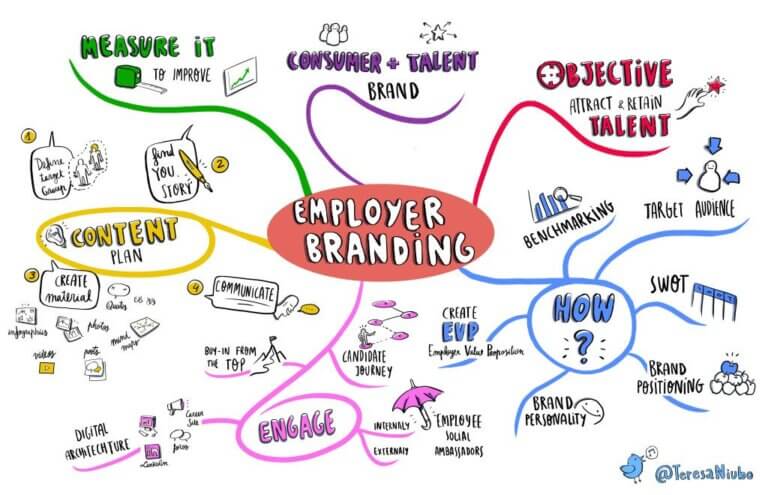With 83% of recruiters agreeing we are in a candidate-driven employment market, establishing an employer brand is more important than ever for startups.
Especially for small startups, every hire can impact your culture and filter down into productivity and quite frankly, your bottom line.
Approximately 83% of recruiters admit we are in a candidate-driven employment market, according to MRINetwork study. The top challenge facing recruiters, is arguably the same top challenge facing startups when hiring: candidates lacking soft skills.
Startups face several obvious disadvantages while attempting to attract top talent: they are for the most part unknown; they are perceived as high-risk; and for many startups, the employer brand messaging has not been fully developed.
For now, let’s discuss the latter.
What is An Employer Brand?
Similar to a product or service’s reputation is determined by the consumer, your employer brand comes down to how your company is perceived as an employer. Your employer brand has the power to attract the ideal candidate but also will dictate your reputation amongst existing employees, customers, within the community and amongst shareholders.
Employer branding is the process of promoting the company, as the employer of choice, to an ideal pool of qualified candidates. The process supports the company’s ability to attract, recruit and retain people that will thrive within their culture and support their business goals.
However, for effective employer brand promotion, the employer brand must be:
- Authentic
- Honest
- Relevant
- Aspirational
Establishing an appealing internal and external employer image necessitates an understanding the audience that it is trying to reach, and specifically what will resonate with them. Only with this information, can the company begin to define its unique employer value proposition that it offers to top talent. Without it, the employer brand cannot be effectively promoted.
What is included in the employer branding process? How do you get started? Look no further. In this blog series, we have outlined the proven steps we recommend to get started with defining your employer brand and employer value proposition as well as, providing a free comprehensive handbook to get your started: The Ultimate Guide for Startup Employer Branding.
Among the first chapter of Pivot + Edge’s free, downloadable eBook for startup employer branding, we cover the debate of purpose verse perks in your employer value proposition (spoiler: it’s not a debate).
Don’t get us wrong, tangible perks such as a remote office budget or unlimited vacation do play into attracting top talent, but it will not differentiate your startup (or lead to loyal, long-term employees). The top four reasons employees leave companies are:
- Lack of Advancement Opportunity
- Lack of Potential Salary Growth
- Negative Work-Life Balance
- Poor Culture
And while you might be sitting there thinking, it doesn’t matter if you only get a year out of an employee if they are talented enough, quick turnover negatively impacts your startup’s finances and reputation. Gone are the days where advertising your ping-pong table and beer on tap in the office can attract you the talent you need to succeed.
Your EVP must come from research on how potential candidates currently view your company in the marketplace and the valuable insight from current employees. By appropriately reflecting your company’s culture and values, and what it’s like to work there, you will be more likely to attract talent who share similar values and who are likely to be satisfied in their role for a longer period of time. Your EVP should be a simple overarching statement that will become the essence of your employee experience and employer brand commitment.
Rather listen? Watch episode one of our four-part startup employer branding series.
How to Start Building Out Your Startup Employer Branding
Today, the most significant obstacle for startup leaders is ensuring they have a ready pipeline of talent that is qualified and a good fit for their culture. Fortunately, you don’t require huge marketing or promotional budgets to compete with the companies in town that are also on your ideal candidate’s radar.
By taking the time to truly understand your business needs and defining your ideal candidates (based on business needs, culture fit and critical competencies), your in-depth understanding will ensure your communication to them will be more effective. Furthermore, giving your team a chance to tell their story will provide a window into your culture, get people talking, peak interest and create excitement amongst the talent pool around working for your company.
Over the next four weeks, we will be breaking down the Pivot + Edge handbook through our blog and in-depth conversations with our President, John Fleischauer, on our LinkedIn and Instagram. Download your free copy of The Ultimate Guide for Startup Employer Branding below and join the conversation.
Investing in developing your employer brand and promoting it may appear overwhelming for small HR departments at startups. It can be a methodological process for anyone familiar with digital marketing and building marketing personas–competencies that you may wish to consider when next recruiting for your own internal HR administration.
Fortunately, you can outsource these exercises to Pivot + Edge to help you attract better applicants faster through a professionally developed Employer Brand Proposition and hiring strategy. Want to learn more? Reach out to our team below and we will get back to you within 48 hours.








